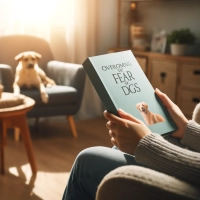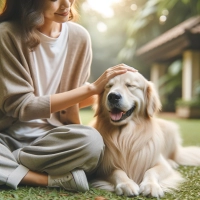Understanding and Overcoming Fear of Dogs: A Psychological Perspective

Many people experience a deep fear of dogs, a condition known as cynophobia. This fear can significantly impact daily life, limiting activities and social interactions. Understanding the psychological roots of this fear and exploring effective strategies to overcome it can lead to a more fulfilling and less restricted life. In this article, we'll delve into the causes of cynophobia, its symptoms, and practical steps to manage and reduce this fear.
What is Cynophobia? Cynophobia is an intense fear of dogs that goes beyond mere discomfort or dislike. It's a specific phobia that can cause significant distress and interfere with a person's daily life. This fear can be triggered by past traumatic experiences, learned behavior, or even media portrayals of aggressive dogs.
Causes of Cynophobia
- Traumatic Experiences: A past encounter with an aggressive or unpredictable dog can leave a lasting impression and trigger a lifelong fear.
- Learned Behavior: Children can develop fear by observing the reactions of fearful adults or peers.
- Genetic Predisposition: Some individuals may have a genetic predisposition to anxiety and phobias, including fear of dogs.
- Media Influence: Movies, news stories, and other media can contribute to the perception of dogs as dangerous, reinforcing the fear.
Symptoms of Cynophobia
- Intense Fear: Overwhelming sense of fear or panic when seeing or thinking about dogs.
- Avoidance Behavior: Actively avoiding places where dogs might be present, such as parks or friends' homes.
- Physical Reactions: Experiencing symptoms like sweating, shaking, rapid heartbeat, and shortness of breath in the presence of dogs.
- Anxiety Attacks: Having anxiety or panic attacks when encountering a dog or even thinking about dogs.
- Negative Thoughts: Persistent negative thoughts about dogs causing harm or danger.
- Nausea: Feeling sick or nauseous at the sight or sound of a dog.
- Distress and Crying: Feeling distressed, crying, or having a strong emotional reaction when near a dog.
- Hypervigilance: Being excessively alert and on edge when in areas where dogs might be present.
- Disruption of Daily Life: Fear of dogs interfering with daily activities, such as walking outside, visiting friends, or going to public places.
- Sleep Disturbances: Experiencing nightmares or trouble sleeping due to fear of dogs.
- Do I feel intense fear or anxiety when I see a dog?
- Have I had any traumatic experiences involving dogs in the past?
- Do I avoid places or activities because there might be dogs present?
- Do I feel embarrassed about my fear of dogs?
- Have I noticed physical symptoms like sweating or trembling when near a dog?
- Do I experience negative thoughts about dogs harming me?
- Have my friends or family commented on my fear of dogs?
- Do I feel a sense of dread when I hear a dog barking?
- Do I avoid visiting friends or family who have dogs?
- Have I sought help or support for my fear of dogs before?
Practical Steps to Overcome Fear of Dogs
Educate Yourself
- Action: Learn about dog behavior and body language.
- Why: Understanding why dogs behave the way they do can reduce fear and misconceptions.
Gradual Exposure
- Action: Start by looking at pictures or videos of dogs, then gradually progress to being near calm, friendly dogs.
- Why: Gradual exposure can help desensitize you to the fear in a controlled and safe manner.
Use Relaxation Techniques
- Action: Practice deep breathing, meditation, or progressive muscle relaxation when feeling anxious around dogs.
- Why: These techniques can help calm your body and mind, reducing the physical symptoms of fear.
Seek Professional Help
- Action: Consult a therapist who specializes in phobias or anxiety disorders.
- Why: Professional guidance can provide tailored strategies and support to overcome the fear.
Join Support Groups
- Action: Connect with others who have similar fears through online or in-person support groups.
- Why: Sharing experiences and coping strategies can provide comfort and encouragement.
Practice Positive Visualization
- Action: Visualize positive interactions with dogs in a calm and safe environment.
- Why: Positive visualization can help reshape negative associations and build confidence.
Use Reward Systems
- Action: Reward yourself for small successes and progress in facing your fear.
- Why: Positive reinforcement can motivate and encourage continued efforts.
Involve a Friend or Family Member
- Action: Have a trusted person accompany you when gradually exposing yourself to dogs.
- Why: Support from someone you trust can provide reassurance and safety.
Learn About Therapy Dogs
- Action: Research therapy dogs and their roles in helping people overcome fears and anxieties.
- Why: Understanding the positive impact of dogs on mental health can shift perceptions and reduce fear.
Set Realistic Goals
- Action: Set small, achievable goals for overcoming your fear, and track your progress.
- Why: Breaking the process into manageable steps can make it less overwhelming and more attainable.
Practical Examples
Example 1: Overcoming Fear through Gradual Exposure The Situation: Sarah had a severe fear of dogs due to a traumatic childhood experience. The Challenge: She couldn't visit friends who had dogs and avoided parks. The Resolution Strategy: Sarah started by watching videos of friendly dogs, then gradually visited a friend with a calm dog, eventually becoming comfortable enough to pet the dog. The Outcome: Over time, Sarah's fear diminished, and she was able to enjoy outdoor activities without anxiety.
Example 2: Using Positive Visualization The Situation: John developed a fear of dogs after being bitten as a child. The Challenge: He experienced panic attacks when seeing dogs on the street. The Resolution Strategy: John practiced visualizing positive encounters with dogs, imagining petting and playing with them. The Outcome: His anxiety lessened, and he was able to pass by dogs without panic.
Example 3: Seeking Professional Help The Situation: Emily's fear of dogs affected her social life, as many friends had pets. The Challenge: She avoided social gatherings and felt isolated. The Resolution Strategy: Emily consulted a therapist who used cognitive-behavioral therapy (CBT) to address her phobia. The Outcome: With professional guidance, Emily gradually overcame her fear and started enjoying social activities again.
Start with Pictures
- Step: Look at pictures of friendly dogs.
- Example: Spend 5 minutes each day looking at photos of cute, calm dogs.
- Why: It’s a gentle way to get used to seeing dogs without any immediate threat.
Watch Videos of Dogs
- Step: Watch short videos of friendly dogs playing or being calm.
- Example: Watch a 2-minute video of a dog playing fetch or being petted.
- Why: Seeing dogs in a positive light helps reduce fear.
Learn Dog Body Language
- Step: Read about how dogs show they are happy or relaxed.
- Example: Find a simple article or a YouTube video about dog body language.
- Why: Understanding dogs better makes them less scary.
Practice Deep Breathing
- Step: When you feel scared, take slow, deep breaths.
- Example: Breathe in for 4 seconds, hold for 4 seconds, and breathe out for 4 seconds.
- Why: It calms your body and mind.
Visualize Positive Interactions
- Step: Imagine yourself playing or walking with a friendly dog.
- Example: Spend 2 minutes each day imagining petting a calm dog.
- Why: Positive visualization reduces fear over time.
Use a Stuffed Animal
- Step: Get a stuffed dog to practice being near something dog-like.
- Example: Keep a stuffed dog on your bed or desk.
- Why: It’s a safe way to get used to the idea of having a dog around.
Talk About Your Fear
- Step: Share your fear with a friend or family member.
- Example: Tell a close friend why dogs scare you.
- Why: Talking about fears makes them less powerful.
Gradual Exposure
- Step: Start with small steps like being near a calm dog on a leash.
- Example: Visit a friend who has a calm dog and stay in the same room for a few minutes.
- Why: Gradual exposure helps you get used to dogs slowly.
Reward Yourself
- Step: Give yourself a small reward for facing your fear.
- Example: After spending time near a dog, treat yourself to a favorite snack.
- Why: Positive reinforcement makes progress enjoyable.
Seek Professional Help
- Step: If your fear is very strong, talk to a therapist.
- Example: Find a therapist who can help with phobias and make an appointment.
- Why: Professional guidance can provide tailored strategies and support.
Dogs Can Sense Human Emotions: Dogs have an incredible ability to sense human emotions through body language, tone of voice, and even facial expressions. This can sometimes trigger anxiety in people who fear dogs, as dogs may respond to their nervousness.
Cynophobia Affects Millions: Approximately 9% of adults in the United States suffer from cynophobia, making it one of the most common specific phobias.
Positive Interaction Can Lower Anxiety: Studies have shown that positive interactions with dogs can significantly reduce levels of cortisol, the stress hormone, in humans, which can help in overcoming fear and anxiety.
Therapy Dogs Aid in Phobia Treatment: Therapy dogs are often used in exposure therapy to help individuals gradually become more comfortable around dogs, ultimately reducing their fear.
Dogs Respond to Human Fear: Dogs are highly sensitive to human emotions and can often sense fear and anxiety in people. This sensitivity can sometimes reinforce the fear in individuals with cynophobia if the dog reacts to their nervousness.
Genetics Play a Role: Research suggests that genetic factors may contribute to the development of specific phobias, including cynophobia, indicating that some people might be more predisposed to fear dogs.
Early Experiences Matter: Negative experiences with dogs during childhood can lead to long-lasting fear and anxiety. Early positive interactions, on the other hand, can foster a healthy relationship with dogs.
Dogs and Mental Health: Owning a dog has been shown to provide numerous mental health benefits, including reducing stress, anxiety, and depression. Understanding these benefits can help in addressing and overcoming the fear of dogs.
Training Reduces Misunderstanding: Proper training for both dogs and their owners can minimize misunderstandings and reduce fear, as well-trained dogs are less likely to exhibit behaviors that might scare people.
Cultural Influences: Cultural background can influence how people perceive dogs. In some cultures, dogs are seen as unclean or dangerous, which can contribute to the development of cynophobia.
Professional Advice and When to Seek Help
- Therapists and Counselors: Specializing in phobias and anxiety disorders.
- Why: They can provide cognitive-behavioral therapy (CBT) and other effective treatments.
- Animal Behaviorists: Experts in understanding and interpreting dog behavior.
- Why: They can offer insights into dog behavior, making them seem less intimidating.
- Support Groups: Communities of people facing similar fears.
- Why: Sharing experiences and coping strategies can be beneficial.
Conclusion
Overcoming cynophobia requires patience, understanding, and a willingness to face your fears gradually. By educating yourself, seeking professional help, and using practical strategies, you can reduce your fear of dogs and improve your quality of life. Remember, each small step you take is a victory, and with persistence, you can conquer your fear and enjoy the many benefits of interacting with dogs.
- "The Other End of the Leash: Why We Do What We Do Around Dogs" by Patricia B. McConnell
- Summary: Insights into the behavior of dogs and their owners, helping you understand how to build a better relationship with dogs.
- "Inside of a Dog: What Dogs See, Smell, and Know" by Alexandra Horowitz
- Summary: Explores how dogs experience the world and what this means for their owners.
- "Decoding Your Dog: Explaining Common Dog Behaviors and How to Prevent or Change Unwanted Ones" by the American College of Veterinary Behaviorists
- Summary: Provides expert insights into common dog behaviors and offers practical solutions to prevent or change unwanted behaviors.
- Video response to the topic: Understanding and Overcoming Fear of Dogs: A Psychological Perspective
While self-care strategies are valuable for managing symptoms related to psychological issues, they are not a substitute for professional treatment. It's important to recognize that self-care complements but does not replace the expert guidance and personalized therapy provided by qualified mental health professionals. Engaging in self-care is beneficial for general well-being and can be part of a broader treatment plan, but it's crucial to consult with a healthcare provider to ensure that you are receiving comprehensive care, especially for complex psychological conditions. This approach ensures that any underlying issues are properly addressed, potentially enhancing the effectiveness of self-care practices.









